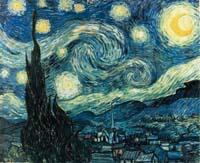Van Gogh's Perfect Swirls
2006/09/01 Elhuyar Zientzia Iturria: Elhuyar aldizkaria

Vincent Van Gogh highlights color and movement. In some works prior to suicide --Starry Night (1889), Cypress and Star Path (1890) and Wheat Field with Candles (1890)- turbulent skies appear. It seems that the swirls are the reflection of the situation of the artist, who at that time suffered psychotic crisis. Now, physicists at the University of Mexico have shown that these seemingly chaotic turbulents correspond to the theory of turbulent flows.
Scientists have needed centuries to describe a turbulent flow that is not easy. The current theory is based on the work done in the 1940s by scientist Andrei Kolmogorov.
The Kolmogorov equation explains the probability of knowing the speed difference between any two points in the flow. Physicists study whether Van Gogh's swirls fit this equation.
To do this they have taken digital images of the pictures and calculated the probability that two separate pixels have the same brightness or brightness. Thus, they have shown that in the swirls painted by Van Gogh the distribution of luminosity depends on the Kolmogorov equation.
Similar figures also appear in works by other artists, such as the painting Garrasia by Eduard Munch, but do not coincide with the equation.




